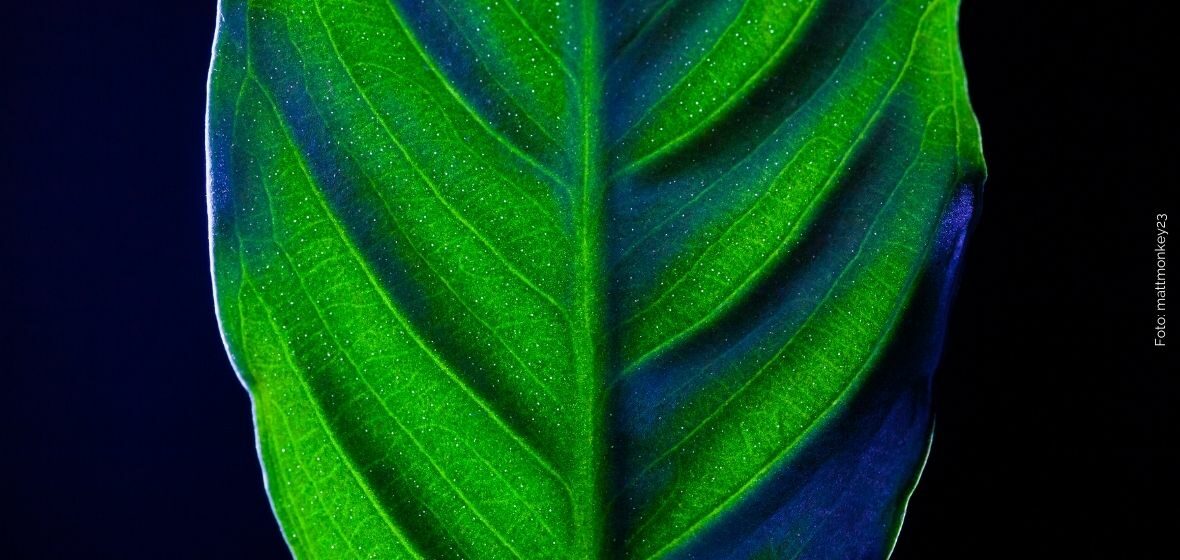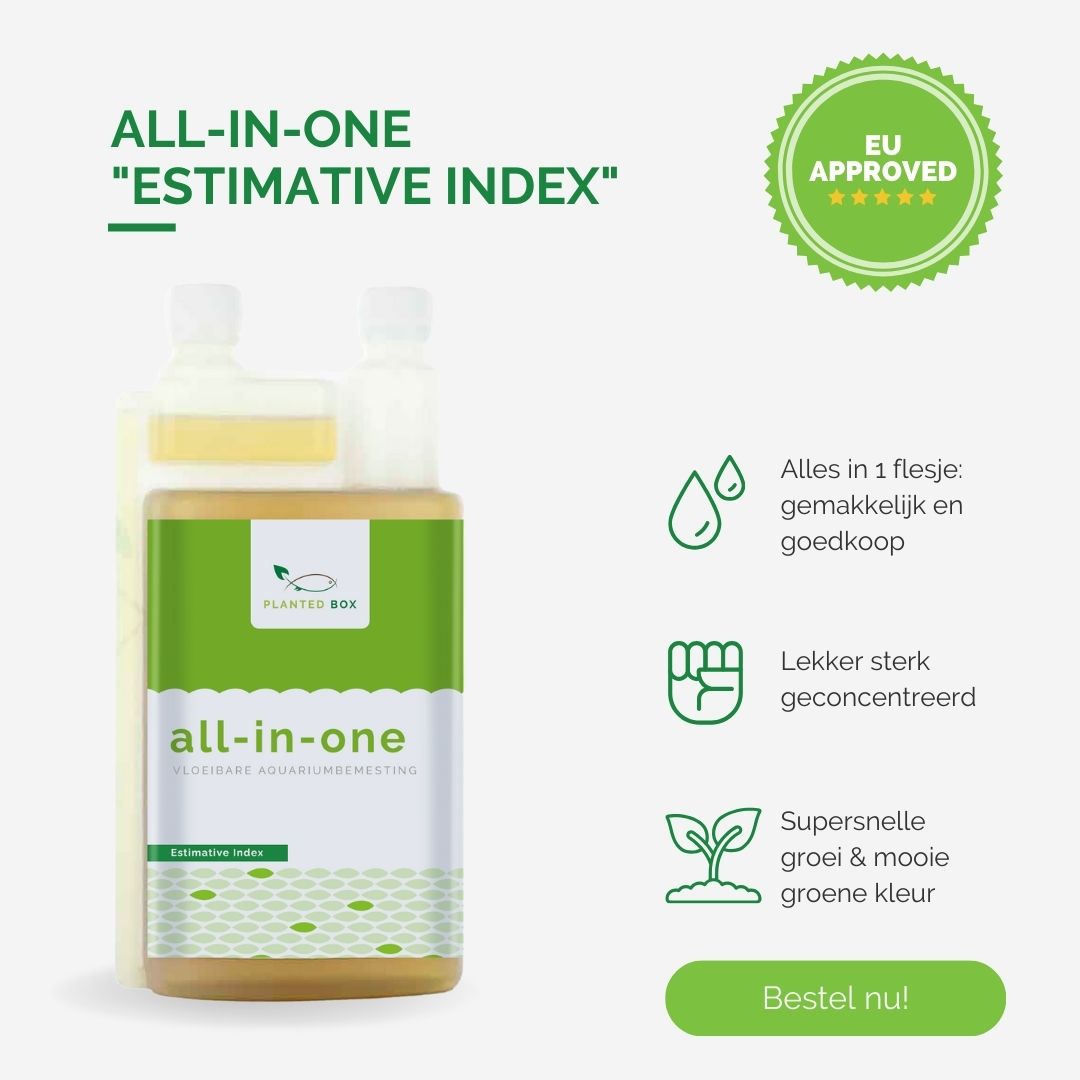You’ve been dreaming of a beautiful aquarium for years. You’ve read about it, created an awesome design and ordered all the right products. Now that everything has arrived, you can already picture your tank taking shape and your aquascape dream becoming a reality.
You leave nothing to chance. Full of excitement (and armed with patience), you start setting up your aquarium. Aquasoil, hardscape, filter… even your plants are already pruned and planted. You carefully fill the tank, and yes, the filter works as expected. You’ve followed an aquarium start-up plan and your lights are set to run for six hours a day.
Nothing could possibly go wrong, right?
And yes, two weeks later, you admire your beautiful planted tank. Lush, green leaves gently swaying in the soft light… Life is perfect!
Oh, wait! What’s that dark green edge on that leaf? Is there some sort of layer on it? Come on, are you really worrying about one leaf? How bad can that be?

Well, it’s bad. You’re looking a the first signs of blue-green algae in your aquarium. And that means only one thing: time to take action. I’ll explain what blue-green algae are, how they appear, how to prevent them and what you need to do to kick them out of your tank.
Oh, no time to read the whole article? Jump directly to the action plan!
What are blue-green algae (BGA) or cyanobacteria?
Cyano-what? Cyanobacteria. Yes, that’s right. Blue-green algae aren’t actually algae—they’re a type of cyanobacteria.
Blue-green algae in an aquarium look like blue-green slime. They can also be recognized by their foul smell if you rub your fingers together after touching some. Blue-green algae are easy to detach from their substrate, where they usually grow on top. But if you’re not careful, blue-green algae blooms can spread all over your substrate and plants.
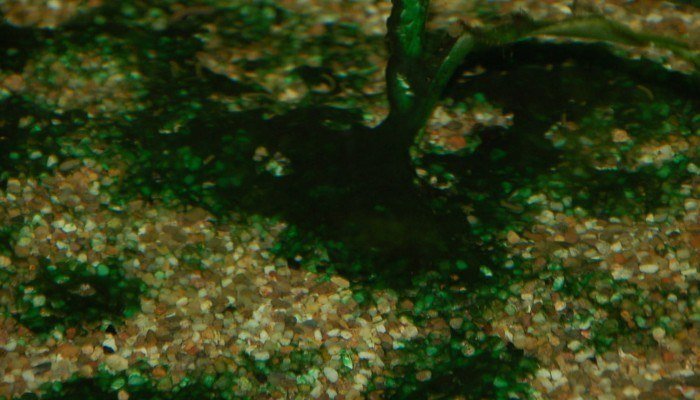
If that happens, your plants don’t get enough light and then will slowly die off. In short, you want to get rid of blue-green algae as soon as possible.
What causes blue-green algae in an aquarium?
The causes of blue-green algae in an aquarium can vary widely. Here are the four main causes of blue-green algae.
Too much waste in your aquarium
Blue-green algae often appear in aquariums with a lot of waste—dirty soil, rotting leaves, or a clogged filter that’s not working properly. All of this excess waste is like a feast for blue-green algae.
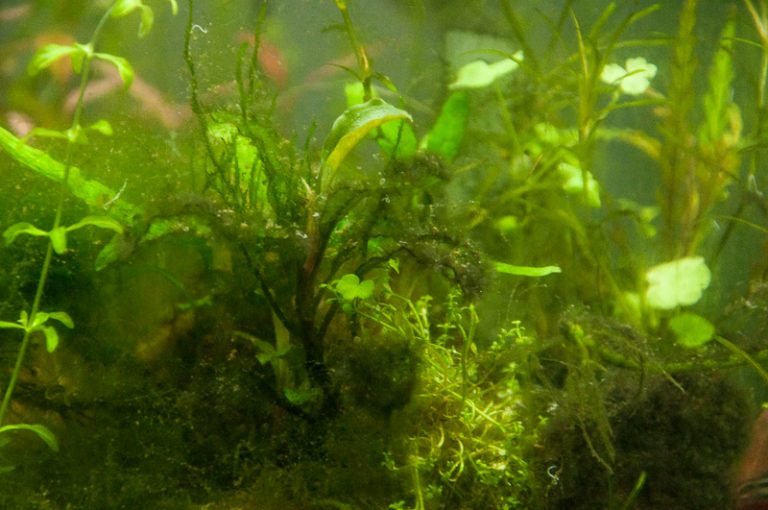
Poor or insufficient water circulation
If you see blue-green algae in specific spots in your aquarium, it’s often due to poor water circulation in your tank.
Why? Because stagnant water creates dead spots—areas with low circulation where plants don’t get enough CO2 or nutrients. As a result, these plants don’t grow well and can even die.
In addition, there can be spots where waste accumulates. Before you know, you get into a vicious circle because in those spots, plants will grow poorly because of a deficiency of CO2 and nutrients. As you may have guessed, they produce more waste, which accumulates there and causes blue-green algae.
Not enough nitrate
According to Tom Barr, the “inventor” of the Estimative Index, blue-green algae in an aquarium are often caused by a nitrate deficiency. His tests showed that blue-green algae often disappeared after the addition of nitrate. Moreover, nitrate is a macroelement for plant growth, including for your aquarium plants. Without nitrates, they grow poorly, rot, and produce waste… and you can guess what happens next.
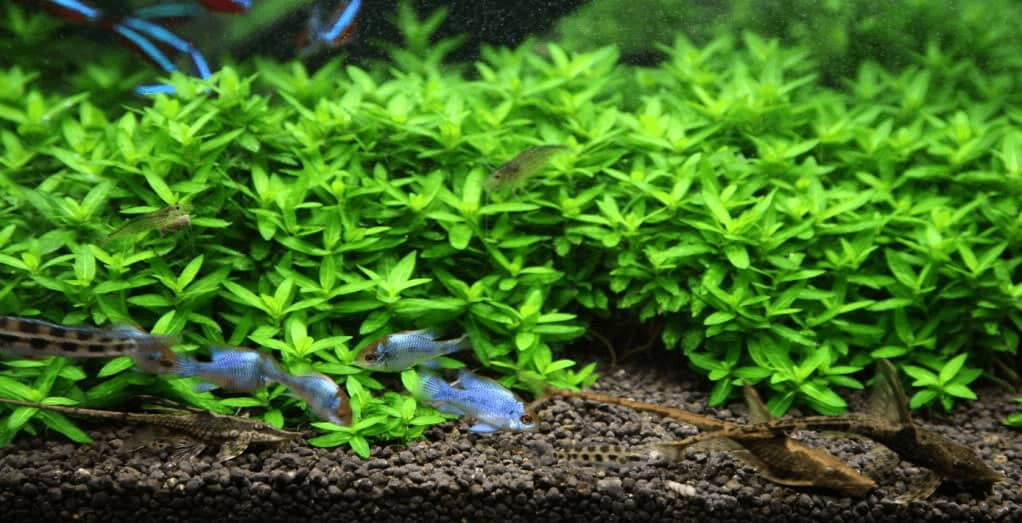
Ammonia spikes
It’s crucial to avoid ammonia spikes in your aquarium. Even a small one can cause blue-green algae (or other algae). Where does ammonia come from? Too many fish, overfeeding, stirring up the substrate, or a poorly functioning filter.
Are blue-green algae dangerous for your fish and plants?
The answer is simple: yes! Blue-green algae are not only toxic to fish and plants but also to humans. You’ve probably heard of cases where lakes are overrun with blue-green algae, and people are warned not to swim.
You probably don’t want to swim in your aquarium, but make sure to wash your hands thoroughly after handling blue-green algae. Blue-green algae may cause digestive symptoms, nausea, abdominal pain, diarrhea, headaches, skin issues, or eye irritation.
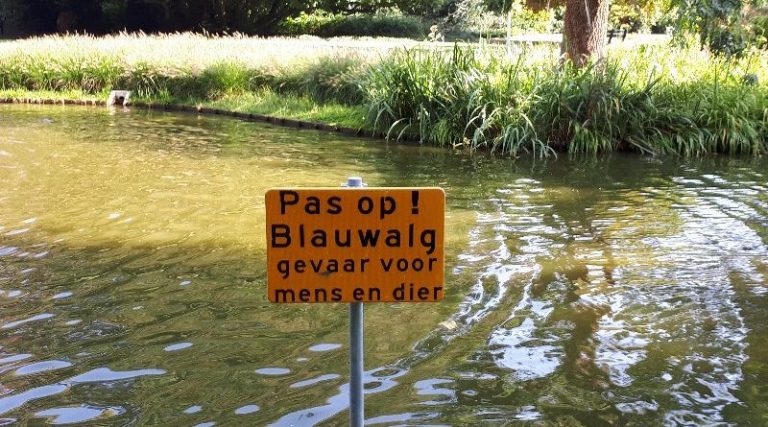
For your fish, the oxygen deficiency due to the blue-green algae bloom can lead to death. For your plants, blue-green algae can be dangerous as they cover the leaves. Your plants get less and less light, dying off and feeding the vicious circle.
In short, you really don’t want BGA in your aquarium. Blue-green algae aren’t just ugly; they’re harmful to everything in your tank. That’s why it’s super important to fight blue-green algae in your aquarium as soon as you notice them.
So, how do you fight blue-green algae in your aquarium?
Alright, we agree that you need to get rid of blue-green algae as quickly as possible. But here’s the thing—blue-green algae are stubborn. So, how do you deal with them? The best approach to remove blue-green algae from your aquarium involves consistency, good preparation, and my personal, tried-and-tested tactic. This strategy consists of 3 steps:
- Preventive measures
- Blackout to kill the blue-green algae
- Chemical treatment to eliminate the last bits of blue-green algae
Below, I’ll explain each step in detail.
Step 1: the right preventive measures against blue-green algae
With a preventive approach, you can stop blue-green algae from invading your aquarium in the first place. You know the saying: “prevention is better than cure”—and it definitely applies here. Below, I’ll walk you through the steps you need to take to make sure you’re prepared. Not every step will apply to your aquarium, but I recommend following them as much as possible.
Ready? Let’s go!
- Clean your filter: Rinse the sponges or replace them if necessary. Don’t forget to clean the impeller and tubing. No need to clean biological filter media.
- Change at least 50% of the water while vacuuming up the blue-green algae, waste in suspension, and any debris on the substrate, like dead leaves. This is crucial!
- Use this moment to clean the glass and decoration with an old toothbrush and remove any remaining dirt or waste.
- Since you’ve cleaned your filter, the water circulation should already be better. Still, if you see room for improvement, consider adding a small circulation pump to help move the water around so that all your plants get some flow.
- Add more nitrate as fertilizer. You can use my All-in-One, which contains plenty of nitrate, or simply add some nitrate separately.
Step 2: time for the famous “blackout”!
No, a blackout doesn’t mean you forget your blue-green algae aquarium problem. A blackout involves placing your aquarium in complete darkness for 2 or 3 days. Blue-green algae can’t survive without light, so they’ll die off. I call it a ridiculously effective method.
What about your fish and plants during a blackout? They won’t be thrilled, but if you keep it to a maximum of 3 days, they won’t suffer any harm. The blue-green algae, however, will likely be dead by then!
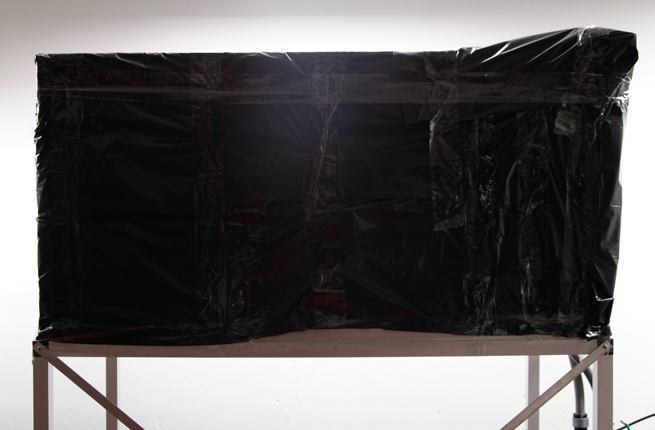
How to perform this blue-green algae aquarium treatment?
- Install an aquarium air pump. This will provide extra oxygen since your plants, deprived from light, won’t be able to produce oxygen during the blackout.
- Turn off your CO2 system (if you use one). Since your plants can’t photosynthesize in the dark, CO2 isn’t needed—and it can even be dangerous in combination with the reduced oxygen levels.
- Shade your aquarium completely: This is the most critical part. You need COMPLETE darkness. Wrap your aquarium in a couple of garbage bags, sealing all the edges tightly. Since garbage bags often let light through, create an extra layer of shade by covering them with cardboard or towels. Carefully check that everything is properly sealed, paying attention to corners and places where equipment enters the tank (like tubing and cables). It won’t look pretty, but trust me, it works.
- Wait: I mean it—literally. Leave your tank alone for a minimum of 2 days and a maximum of 3. A quick peek is NOT the same as leaving it alone! If you disturb it, you’ll have to start over.
Step 3: chemical blue-green algae aquarium treatment
Once the 3-day blackout is over, it’s time to remove the cover. Proceed carefully, layer by layer. A bad smell is normal because your tank has been sealed off from fresh air. Once you’ve removed the garbage bags and your tank is back in daylight, you can resume your work:
- Change at least 50% of the water
- Remove the air pump and turn your CO2 system back on
- Add nitrate (like in step 1), plus other nutrients such as trace elements, phosphate, and iron. You can also use my All-in-One to add everything in one go.
- Turn the aquarium lights on and check if the timer is still correct
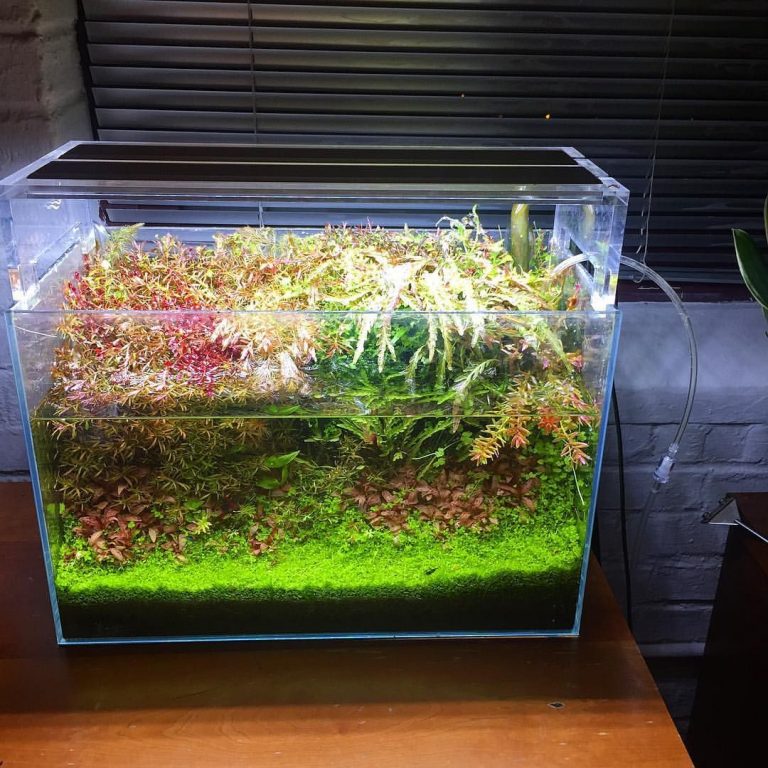
OK, now we’re at the very last step: the chemical treatment. Normally, I don’t like using anti-algae products. They only treat the symptoms, not the root cause. But here’s why I’m okay with using an anti-algae product in this case: you’ve already addressed the root cause of the problem. Plus, this product is not a pesticide like some other anti-algae treatments.
How to proceed?
- Remove the activated charcoal from your filter, if applicable
- Add 10ml of anti-blue-green algae product per 80 liters of aquarium water for 5 to 6 days
- After completing the treatment, change 50% of the water again and add plant fertilizer
And there you have it—your tank is now free from blue-green algae!
Conclusion: fighting blue-green algae is tedious, but effective
Now it’s time to celebrate, but also remember that blue-green algae need to be dealt with immediately. Don’t put it off, or you’ll regret it. Guaranteed.
Blue-green algae don’t just disappear on their own—quite the opposite. But if you stick to a few basic principles, you can prevent them from coming back in the future. And if they do show up again, don’t panic; this method will help you get rid of them:
- Start with a preventive approach and remove as much blue-green algae as possible while cleaning your aquarium and filter
- Do the blackout for 2 to 3 days
- Turn your equipment back on, change 50% of the water and complete the chemical treatment
Then, enjoy your beautiful, algae-free aquarium!







